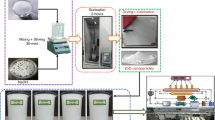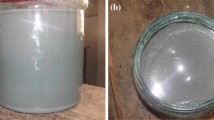Abstract
The heat transfer improvement using nanofluids inside varying shape heat exchangers is a still challenge to avoid from heat losses in chemical and petrochemical industries. In the stated study, the friction loss (f), pressure drop (∆P), average heat (have) transfer and average Nusselt (Nuave) numbers were evaluated numerically (ANSYS-FLUENT) and experimentally at varying 0.025 mass%, 0.05 mass%, 0.075 mass%, and 0.1 mass% concentrations of the low dimensional Zinc nanospheres-based nanofluids and base fluid (DW) in the square shaped heat exchanger. All the nanofluids and base fluid (DW) were assessed both experimentally and numerically for different thermophysical, hydrodynamic, and heat transfer characteristics. The addition of Zinc nanospheres in base fluid (DW) showed enhanced energy transportation at all mass% concentrations numerically and experimentally against Reynold numbers (Re) changing from 4550 to 20,367. Thermal conductivity, viscosity and density were measured at varying temperature ranges from 20 to 45 °C, where different changes were recorded in all properties against temperature values. Further, 2-D numerical model for single nanofluids was validated using laboratory scale distilled water (DW) as a base liquid. Further continuity, momentum, and energy equations were been evaluated by constructing a k−ɛ model and 2-dimensional domain. The maximum pressure drop (∆P/L) was recorded at 0.1 mass% which is 5152.72 m.Pas, while the friction loss (f) was 0.0188. Similarly, the average heat transfer (h) and Nusselt numbers (Nu) were calculated numerically and experimentally, where it has found the maximum heat transfer was 7095.25 Wm2 K−1 (61%) and the average Nusselt numbers (Nu) were 93.73 (57.3%) at the highest 0.1 mass%. Both numerical (ANSYS) and experimental results showed improved energy transportation at 0.1 mass% concentration against the highest Reynold number (Re) in comparison to base fluid (DW) and other mass%. The consequences confirmed the significance of the ANSYS model and experimental results with an average difference of ± 8.1%.
Graphical abstract















Similar content being viewed by others
Change history
23 January 2023
A Correction to this paper has been published: https://doi.org/10.1007/s10973-023-11963-2
Abbreviations
- Z ns :
-
Zinc nanospheres
- D h :
-
Pipe hydraulic diameter
- N P :
-
Nanoparticles
- BF:
-
Base fluid
- DW:
-
Distill water
- ff:
-
Friction factor/loss
- Pr:
-
Prandtl numbers
- L :
-
Medium total length (m)
- Re:
-
Reynold numbers
- L :
-
Medium total length (m)
- W:
-
Walls of pipe
- T:
-
Temperature (°C)
- NF :
-
Nanofluids
- Tw:
-
Pipe wall temperature
- u:
-
Velocity
- mass%:
-
Mass concentration
- Dp:
-
Nanoparticle diameter (nm)
- V:
-
Velocity (m s–1)
- K:
-
Thermal conductivity
- ∆P:
-
Pressure drop
- Cp:
-
Specific heat kJ kg −1 K–1
- T b :
-
Temperature in bulk (K)
- Nuave :
-
Average Nusselt (Nu) Numbers
- Q″:
-
Total heat flux (W m–2)
- Re:
-
Reynold numbers
- ρ :
-
Density (kg m–3)
- µ :
-
Fluid Viscosities in (N m s–1)
- Φ:
-
Volumetric friction of fluids
- V :
-
Kinematic viscosity (m2s–1)2
References
Sadri R, et al. CFD modeling of turbulent convection heat transfer of nanofluids containing green functionalized graphene nanoplatelets flowing in a horizontal tube: comparison with experimental data. J Mol Liq. 2018;269:152–9.
Ahmed W, et al. Effect of ZnO-water based nanofluids from sonochemical synthesis method on heat transfer in a circular flow passage. Int Commun Heat Mass Transf. 2020;114: 104591.
Trisaksri V, Wongwises S. Critical review of heat transfer characteristics of nanofluids. Renew Sustain Energy Rev. 2007;11(3):512–23.
Ahmed W, et al. Characteristics investigation on heat transfer growth of sonochemically synthesized ZnO-DW based nanofluids inside square heat exchanger. J Therm Anal Calorim. 2020;144:1517–34.
Akram N, et al. An experimental investigation on the performance of a flat-plate solar collector using eco-friendly treated graphene nanoplatelets–water nanofluids. J Therm Anal Calorim. 2019;138(1):609–21.
Akram N, et al. A comprehensive review on nanofluid operated solar flat plate collectors. J Therm Anal Calorim. 2020;139(2):1309–43.
Almatar AbdRabbuh O, et al. An experimental investigation of eco-friendly treated GNP heat transfer growth: circular and square conduit comparison. J Therm Anal Calorim. 2020;149:139–51.
Mujtaba MA, et al. Comparative study of nanoparticles and alcoholic fuel additives-biodiesel-diesel blend for performance and emission improvements. Fuel. 2020;279: 118434.
Mujtaba MA, et al. Ultrasound-assisted process optimization and tribological characteristics of biodiesel from palm-sesame oil via response surface methodology and extreme learning machine—Cuckoo search. Renew Energy. 2020;158:202–14.
Namburu PK, et al. Numerical study of turbulent flow and heat transfer characteristics of nanofluids considering variable properties. Int J Therm Sci. 2009;48(2):290.
Togun H, et al. Thermal performance of nanofluid in ducts with double forward-facing steps. J Taiwan Inst Chem Eng. 2015;47:28–42.
Abdelrazek AH, et al. A new approach to evaluate the impact of thermophysical properties of nanofluids on heat transfer and pressure drop. Int Commun Heat Mass Transf. 2018;95:161–70.
Ozbolat V, Sahin B. Numerical investigations of heat transfer enhancement of water-based Al2O3 nanofluids in a sinusoidal-wall channel. In: ASME 2013 international mechanical engineering congress and exposition. 2013
Suresh S, Chandrasekar M, Chandra Sekhar S. Experimental studies on heat transfer and friction factor characteristics of CuO/water nanofluid under turbulent flow in a helically dimpled tube. Exp Therm Fluid Sci. 2011;35(3):542–9.
Ahmed W, et al. One-pot sonochemical synthesis route for the synthesis of ZnO@TiO2/DW hybrid/composite nanofluid for enhancement of heat transfer in a square heat exchanger. J Therm Anal Calorim. 2020;143:1139–55.
Duraisamy N, et al. Facile sonochemical synthesis of nanostructured NiO with different particle sizes and its electrochemical properties for supercapacitor application. J Colloid Interface Sci. 2016;471:136–44.
Numan A, et al. Sonochemical synthesis of nanostructured nickel hydroxide as an electrode material for improved electrochemical energy storage application. Prog Nat Sci Mater Int. 2017;27(4):416–23.
Numan A, et al. Facile fabrication of cobalt oxide nanograin-decorated reduced graphene oxide composite as ultrasensitive platform for dopamine detection. Sens Actuators B Chem. 2017;238:1043–51.
Shahid MM, et al. Enhanced electrocatalytic performance of cobalt oxide nanocubes incorporating reduced graphene oxide as a modified platinum electrode for methanol oxidation. RSC Adv. 2014;4(107):62793–801.
Sharma KV, Sarma PK, Azmi WH, Mamat R, Kadirgama K. Correlations to predict friction and forced convection heat transfer coefficients of water based nanofluids for turbulent flow in a tube. Int J Microscale Nanoscale Therm Fluid Transp Phenom. 2012;3(4):1–25.
Xuan Y, Roetzel W. Conceptions for heat transfer correlation of nanofluids. Int J Heat Mass Transf. 2000;43(19):3701–7.
Bergman TL, et al. Fundamentals of heat and mass transfer. New York: Wiley; 2011.
Akilu S, Baheta AT, Minea AA, Sharma KV. Rheology and thermal conductivity of non-porous silica (SiO2) in viscous glycerol and ethylene glycol based nanofluids. Int Commun Heat Mass Transf. 2017;88:245–53.
Petukhov BS. Heat transfer and friction in turbulent pipe flow with variable physical properties. Adv Heat Transf. 1970;6(503):i565.
Hanjalić K, Launder BE. A Reynolds stress model of turbulence and its application to thin shear flows. J Fluid Mech. 1972;52(4):609–38.
Fernández-Seara J, Uhía FJ, Sieres J, Campo A. A general review of the Wilson plot method and its modifications to determine convection coefficients in heat exchange devices. Appl Therm Eng. 2007;27(17–18):2745–57.
Acknowledgements
The author would appreciate the grant R.K130000.7343, the international grant and Takasago Thermal System for all kinds of support. Also, I would like to acknowledge UTM OCEAN Thermal Energy Center (OTCE) and Takasago i-Kohza, Malaysia-Japan International Institute of Technology, Universiti Teknologi Malaysia, Kuala Lumpur, for providing me opportunity to lead my research in positive direction. The author also would like to appreciate Dr. Hussein Togun and Balaji Bakthavatchalam for their help to improve the manuscript language.
Author information
Authors and Affiliations
Corresponding authors
Ethics declarations
Conflict of interest
The author doesn’t have any conflict of research interest.
Additional information
Publisher's Note
Springer Nature remains neutral with regard to jurisdictional claims in published maps and institutional affiliations.
The original online version of this article was revised: The third author’s affiliation was tagged incorrectly as 3 instead of 1. The affiliations 4 to 8 were mentioned incorrectly. The corrected affiliations were given below.
Rights and permissions
Springer Nature or its licensor (e.g. a society or other partner) holds exclusive rights to this article under a publishing agreement with the author(s) or other rightsholder(s); author self-archiving of the accepted manuscript version of this article is solely governed by the terms of such publishing agreement and applicable law.
About this article
Cite this article
Ahmed, W., Alawi, O.A., Abdelrazek, A.H. et al. Numerical and experimental evaluation of thermal enhancement using zinc nano-suspensions in a square flow passage. J Therm Anal Calorim 148, 551–570 (2023). https://doi.org/10.1007/s10973-022-11734-5
Received:
Accepted:
Published:
Issue Date:
DOI: https://doi.org/10.1007/s10973-022-11734-5




